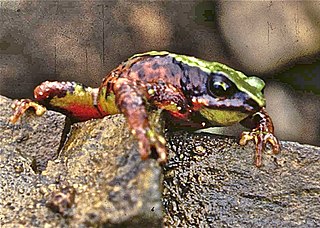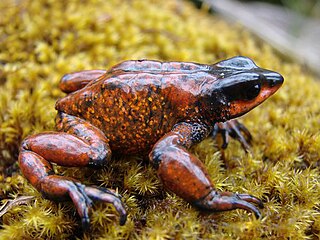Atelopus angelito, the Angelito stubfoot toad, is a species of toads in the family Bufonidae endemic to Colombia. Its natural habitats are subtropical or tropical moist montane forests, subtropical or tropical high-altitude shrubland, and rivers.

Atelopus arthuri, Arthur's stubfoot toad, is a species of toad in the family Bufonidae endemic to Ecuador. Its natural habitats are subtropical or tropical moist montane forests, subtropical or tropical high-altitude grasslands, and rivers. It is threatened by habitat loss. It has not been seen since the nineteen eighties and is considered probably extinct.
The Rio Carauta stubfoot toad is a species of toad in the family Bufonidae endemic to Colombia; this anuran is found only within the Northwestern Andean montane forests. Its natural habitats are subtropical or tropical moist montane forests and rivers. The species is threatened by habitat loss.

The Guajira stubfoot toad or Carrikeri harlequin frog is a species of toad in the family Bufonidae. It is about 5 cm (2.0 in) long and typically black, though some populations have orange coloration. This species is endemic to the Sierra Nevada de Santa Marta mountain range of northern Colombia. It is critically endangered because of the chytrid fungus, Batrachochytrium dendrobatidis, and habitat destruction due to agriculture. The species had not been seen from 1994 until it was rediscovered in early 2008.
Atelopus galactogaster, the Antado stubfoot toad, is a species of toad in the family Bufonidae endemic to Colombia within the northwestern Andean montane forests. The species' natural habitat is subtropical or tropical moist montane forests.

Atelopus glyphus, the Pirri harlequin frog or Pirri Range stubfoot toad, is a species of toad in the family Bufonidae found in Colombia and Panama within the Northwestern Andean montane forests. Its natural habitats are subtropical or tropical moist montane forests and rivers.
Atelopus halihelos, the Morona-Santiago stubfoot toad, is a species of toad in the family Bufonidae endemic to Ecuador. Its natural habitats are subtropical or tropical moist montane forests and rivers. It is threatened by habitat loss.
Atelopus lynchi is a species of toad in the family Bufonidae. It is endemic to Ecuador. Its natural habitats are subtropical or tropical moist lowland forests, subtropical or tropical moist montane forests, and rivers. It is threatened by habitat loss.
Atelopus mandingues is a species of toads in the family Bufonidae.
Atelopus muisca is an extinct species of toad in the family Bufonidae. It is endemic to Colombia. Its natural habitats were subtropical or tropical moist montane forests, subtropical or tropical high-altitude grassland, and rivers. It is threatened by habitat loss.
Atelopus petriruizi, more commonly known as the painted stubfoof toad, is a species of toad in the family Bufonidae. Endemic to Colombia, the toad's natural habitats are subtropical or tropical moist montane forests and rivers. Threatened by habitat loss, the Ateopus petriruizi is currently classified as critically endangered, and was placed on the IUCN red list in 2017. Currently, there may be less than 49 remaining mature A. Petriruizi.
Atelopus sernai is a species of toad in the family Bufonidae. It is endemic to the northern Andes of Colombia. Its natural habitats include subtropical or tropical moist montane forests, subtropical or tropical high-altitude grassland, and rivers. It is threatened by habitat loss.

The African common toad or guttural toad is a species of toad in the family Bufonidae. It is found in Angola, Botswana, Democratic Republic of the Congo, Kenya, Lesotho, Malawi, Mauritius, Mozambique, Namibia, Réunion, Somalia, South Africa, Ethiopia, Eswatini, Tanzania, Zambia, and Zimbabwe. Its natural habitats are subtropical or tropical dry forest, subtropical or tropical moist lowland forest, subtropical or tropical moist montane forest, dry savanna, moist savanna, temperate shrubland, subtropical or tropical dry shrubland, subtropical or tropical moist shrubland, subtropical or tropical dry lowland grassland, subtropical or tropical seasonally wet or flooded lowland grassland, subtropical or tropical high-altitude grassland, intermittent rivers, freshwater lakes, intermittent freshwater lakes, freshwater marshes, intermittent freshwater marshes, arable land, pastureland, rural gardens, urban areas, heavily degraded former forest, ponds, and canals and ditches.
"Centrolene" petrophilum is a species of frog in the family Centrolenidae. Also called the Boyaca Giant Glass Frog.

Cochranella nola is a species of frog in the family Centrolenidae, the glass frogs, so named because of the transparent skin on the underside of the abdomen through which the internal organs can be seen. This species is endemic to Bolivia where it is found in the Andean foothills in the Santa Cruz Department. Its natural habitats are subtropical or tropical moist montane forests and rivers. The scientific name nola is Latin for "small bell", and refers to the high-pitched, bell-like call of the male in the breeding season.

The Sierra Juarez brook frog is a species of frog in the family Hylidae endemic to Mexico. Its natural habitats are subtropical or tropical moist lowland forests, subtropical or tropical moist montane forests, and rivers. It is threatened by habitat loss and possibly by chytridiomycosis, and the IUCN has assessed its conservation status as near threatened.

The New England tree frog or glandular tree frog is a species of frog in the subfamily Pelodryadinae, endemic to Australia. Its natural habitats are temperate forests, subtropical or tropical moist lowland forests, subtropical or tropical moist montane forests, temperate shrubland, rivers, and pastureland. It is threatened by habitat loss.

The Natal dwarf puddle frog is a species of frog in the family Phrynobatrachidae. It is found in Angola, Benin, Botswana, Burundi, Cameroon, Central African Republic, Republic of the Congo, Democratic Republic of the Congo, Ivory Coast, Eswatini, Eritrea, Ethiopia, Gambia, Ghana, Guinea, Guinea-Bissau, Kenya, Liberia, Malawi, Mali, Mozambique, Namibia, Nigeria, Rwanda, Senegal, Sierra Leone, South Africa, Sudan, Tanzania, Togo, Uganda, Zambia, Zimbabwe, and possibly Burkina Faso, Chad, Lesotho, and Mauritania.

The Northwestern Andean montane forests (NT0145) is an ecoregion on the Andes mountains in the west of Colombia and Ecuador. Both flora and fauna are highly diverse due to effect of ice ages when the warmer climate zones were separated and the cooler ones combined, and interglacial periods when the reverse occurred. Because the environment is hospitable to humans, the habitat has been drastically modified by farming and grazing since the Pre-Columbian era.

The Eastern Cordillera Real montane forests (NT0121) is an ecoregion in the eastern range of the Andes of southern Colombia, Ecuador and northern Peru. The ecoregion covers the eastern slopes of the Andes, and includes montane forest that rises from the Amazonian rain forest, with cloud forest and elfin forest at higher elevations. It is rich in species, including many endemics. It is threatened by logging and conversion for pasturage and subsistence agriculture.











